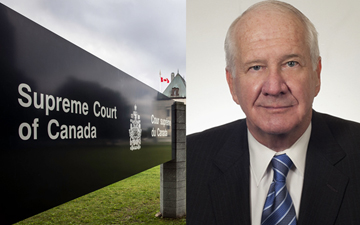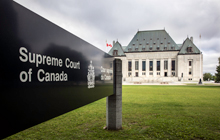Alta Energy: Has the GAAR become toothless? – Part II

In part two of his two-part series, Allan Lanthier highlights areas of the Supreme Court's Alta Energy decision that are open to vigorous debate
Montreal – In late November, the Supreme Court of Canada (SCC) issued its decision in Alta Energy[1], a case that involved aggressive tax avoidance using a tax haven corporation in Luxembourg, and the application of Canada’s general anti-avoidance rule (GAAR).[2]
In a 6 to 3 decision, a divided court concluded that the GAAR did not apply and, as a result, that a capital gain of $380 million was exempt from Canadian tax under the Canada-Luxembourg tax treaty. Under a tax ruling that had been secured from the Luxembourg tax authorities, there was no tax in that country either. The result was double non-taxation — the Holy Grail of tax avoidance!
Part I of this article described the relevant transactions, and summarized the court’s analysis. This Part II critiques parts of the majority’s analysis, and then discusses the possible impact of the decision. First, the critique.
Parts of the majority’s analysis are open to vigorous debate: in particular (1) the search for a specific anti-avoidance rule to support the application of the GAAR; (2) the little weight given to section 4.1 of the Income Tax Conventions Interpretation Act[3]; and (3) the reliance on the intention of the treaty drafters rather than the purpose of the treaty provisions.
The search for a specific anti-avoidance rule (SAAR)
The majority searched for a SAAR within the treaty to support the application of the GAAR, to no avail. Justice Côté stated that the absence of a SAAR shed light on the intention of Canada to leave conduit corporations unguarded to promote inbound investment. With respect, Justice Côté missed the point.
The GAAR is a provision that was enacted to replace SAARs, not rely on them. As David Dodge, Senior Assistant Deputy Minister of Finance wrote when the GAAR was being introduced, “Although specific anti-avoidance rules arguably provide more certainty … they cannot possibly represent a general approach to tax avoidance.” “Proposed section 245 is precisely intended to minimize the need to respond repeatedly to abusive strategies by enacting specific legislation…”[4]
The Income Tax Conventions Interpretation Act (ITCIA)
As a result of uncertainty whether the GAAR applied to tax treaties, the ITCIA was amended in 2005, retroactive to 1988, to ensure that it does. Section 4.1 was added to that statute and provides that, notwithstanding the provisions of a tax treaty, it is declared that the law of Canada is that the GAAR applies to any benefit provided under the treaty.
By enacting section 4.1 of the ITCIA, the Parliament of Canada unilaterally overrode its tax treaty agreements and required that the GAAR apply to the provisions of our tax treaties in the case of avoidance transactions.
The majority made only passing reference to the ITCIA, and focused instead on the intention of the treaty drafters. “Parties to a treaty must keep their sides of the bargain,” Justice Côté said, even though the Parliament of Canada had already unilaterally changed that bargain.
Intention or purpose?[5]
The majority focused on the intention (the state of mind) of the treaty drafters, rather than the object and purpose of the relevant treaty provisions. While Justice Côté conceded that “the first step of the abuse analysis is to ascertain the object, spirit, and purpose of the relevant provisions,” she added that “Because this is a question of treaty interpretation, however, this must be done with a view to implementing the true intentions of the parties.”
However, in addition to the treaty, the case involved two Canadian statutes — the Income Tax Act which includes the GAAR, and a unilateral treaty override in the ITCIA enacted after the treaty was in force. The Canadian courts have emphasized legislative purpose (not intention) when considering GAAR in the domestic context: should purpose not be paramount as well in a GAAR inquiry involving treaty shopping?[6] Had the majority focused on a purposive analysis of article 13(4), it might well have concluded that there was support for a finding of abuse.[7]
Is it open season for treaty shopping?
Given the majority’s conclusion in Alta Energy, one question is whether the GAAR — in its current form — can ever apply to treaty shopping under any circumstances. After all, the facts could hardly have been worse.
The Luxembourg-flip was put in place long after the U.S. Principals[8] decided to invest in oil and gas licences, and after $210 million of the final cost of $300 million had already been spent. And so, while one of the purposes of article 13(4) of the treaty may have been to attract foreign investment to Canada, that investment was, in large part, in place by the time of the flip.
All parties agreed that Luxco had virtually no economic connection with Luxembourg, and that the sole purpose of the Luxembourg-flip was the avoidance of Canadian tax. Finally, as a result of a financial derivative (the Luxco Debt), Luxco did not receive a penny from Chevron. Instead, the U.S. Principals, corporations that had no treaty protection from Canadian tax, received the cash of $680 million. [9]
If the taxpayer can prevail against these facts, can the Minister ever succeed when asserting treaty abuse? There are at least two developments to consider: the government’s consultations on the GAAR, and the new “principal purpose test” that Canada has enacted as part of the “multilateral instrument.”
The GAAR consultations
The GAAR is in need of repair, a fact that the federal government recognized even before the decision in Alta Energy. In its 2020 Fall Economic Update, the government stated it would launch consultations on the modernization of the GAAR to better address aggressive tax planning — a promise that was repeated in one sentence of the 725-page federal budget earlier this year — and it is understood that the government is proceeding with internal consultations at this time.
The multilateral instrument
In 2019, the federal government enacted Bill C-82 to implement the OECD-sponsored multilateral instrument (“MLI”).[10] Under article 7 of the MLI (Prevention of Treaty Abuse), countries could adopt a “principal purpose test” (“PPT”), as well as a “simplified limitation-of-benefits” (LOB) provision. Canada stated it would implement the PPT alone as an interim measure, and adopt comprehensive LOBs in future through bilateral negotiation, in addition to or in replacement of the PPT.
Under the PPT, a treaty benefit shall not be granted if it is reasonable to conclude that obtaining the benefit was one of the principal purposes of any transaction, unless it is established that granting the benefit would be in accordance with the “object and purpose” of the relevant treaty provision. Given the PPT’s reliance on object and purpose, it is difficult to see how its application would have differed in Alta Energy from that of the GAAR. However, there were “recitals” included in the MLI, including ensuring that profits are taxed where substantive economic activities generating the profits are carried out, and noting the need to address non-taxation through tax avoidance, including treaty-shopping arrangements.
Had the PPT been in place at the time of the Alta Energy transactions, might the majority have concluded that the Luxembourg-flip constituted an abuse under the PPT as a result of the recitals, even with a finding of no abuse under the GAAR? Given the GAAR consultations and other legislative initiatives that the Canadian government may now be considering to respond to the Alta Energy decision, we may never know.
Footnotes
[1] Canada v. Alta Energy Luxembourg S.A.R.L.: 2021 SCC 49.
[2] Section 245 of the Canadian federal Income Tax Act: RSC 1985, c. 1 (5th Supp.), as amended.
[3] RSC 1985, c. I-4.
[4] David A. Dodge; “A New and More Coherent Approach to Tax Avoidance”, Canadian Tax Journal, January-February 1988, 36:1.
[5] In this and other parts of this article, I have benefitted from the thoughts and analysis of Jinyan Li: any errors are my own. For Professor Li's analysis of the decision, see "Finding the Purpose of Tax Treaty Provisions Under GAAR: Lessons From Alta Energy": Tax Notes International, Volume 105, January 2022.
[6] Article 31 of the Vienna Convention on the Law of Treaties (VCLT) states that the terms of a treaty shall be interpreted in light of their context and the treaty’s object and purpose. The VCLT governs the interpretation of international tax treaties and has been ratified by 116 countries, including Canada and Luxembourg.
[7] Li (supra, footnote 5) argues that article 13(4) should be viewed as part of the general scheme of the treaty for allocating taxing rights as opposed to a deliberate tax incentive, and that this offers stronger support for the dissent’s view that treaty residence requires a genuine economic connection with the country of residence.
[8] As described in Part I of this article, the “U.S. Principals” were the two U.S. groups that were the ultimate shareholders. The U.S. Principals initially formed a Delaware limited liability corporation (“LLC”), with “Alta Canada” as LLC’s wholly-owned Canadian subsidiary. Well after the fact – to eliminate Canadian tax – the U.S. Principals entered into a partnership agreement governed by the laws of Alberta (the “Alberta Partnership”), the Alberta Partnership formed “Luxco” (a Luxembourg corporation) as its wholly-owned subsidiary, and LLC sold the shares of Alta Canada to Luxco for a demand note. The Alberta Partnership provided virtually all of its funding to Luxco in the form of a derivate financial instrument — the “Luxco Debt.”
[9] Through a conduit — the Alberta Partnership.
[10] Multilateral Instrument in Respect of Tax Conventions Act: Statutes of Canada 2019, c. 12.
[7] Li (supra, footnote 5) argues that article 13(4) should be viewed as part of the general scheme of the treaty for allocating taxing rights as opposed to a deliberate tax incentive, and that this offers stronger support for the dissent’s view that treaty residence requires a genuine economic connection with the country of residence.
[8] As described in Part I of this article, the “U.S. Principals” were the two U.S. groups that were the ultimate shareholders. The U.S. Principals initially formed a Delaware limited liability corporation (“LLC”), with “Alta Canada” as LLC’s wholly-owned Canadian subsidiary. Well after the fact – to eliminate Canadian tax – the U.S. Principals entered into a partnership agreement governed by the laws of Alberta (the “Alberta Partnership”), the Alberta Partnership formed “Luxco” (a Luxembourg corporation) as its wholly-owned subsidiary, and LLC sold the shares of Alta Canada to Luxco for a demand note. The Alberta Partnership provided virtually all of its funding to Luxco in the form of a derivate financial instrument — the “Luxco Debt.”
[9] Through a conduit — the Alberta Partnership.
[10] Multilateral Instrument in Respect of Tax Conventions Act: Statutes of Canada 2019, c. 12.
Allan Lanthier is a retired partner of an international accounting firm, and has been an advisor to both the Department of Finance and the Canada Revenue Agency.










(0) Comments